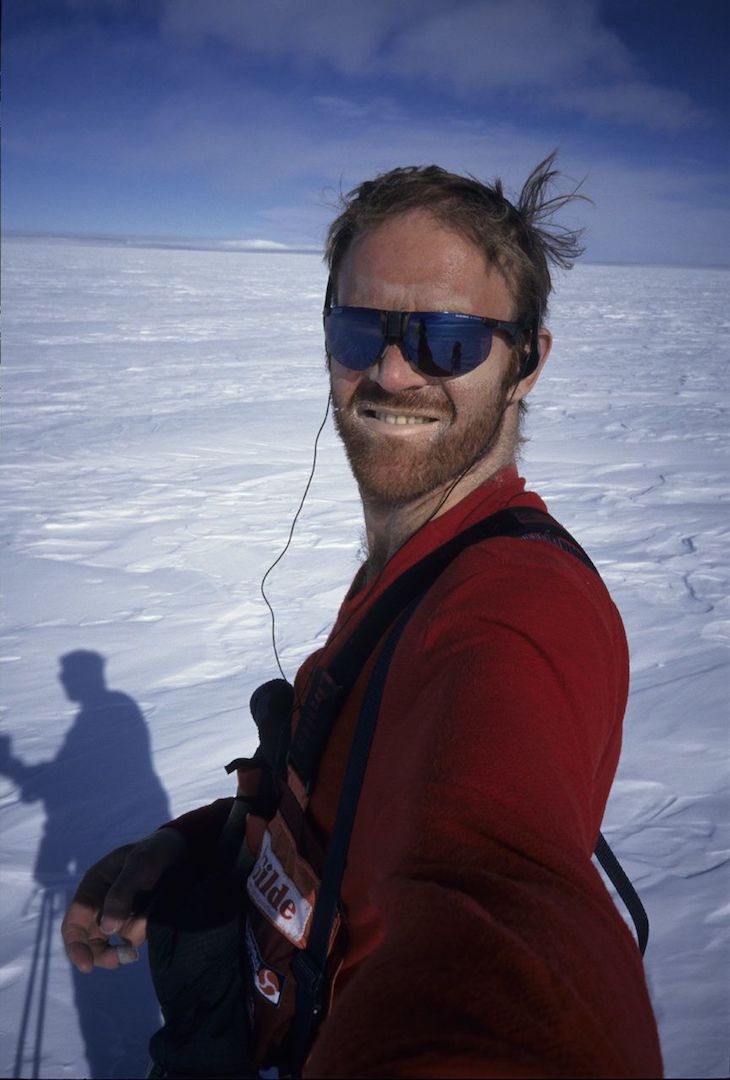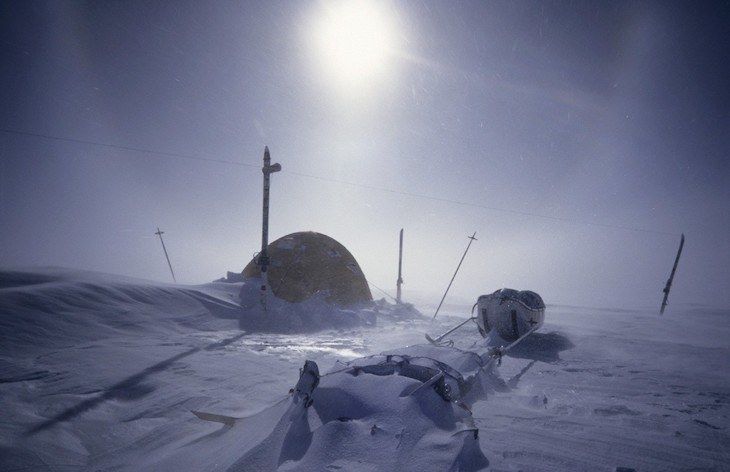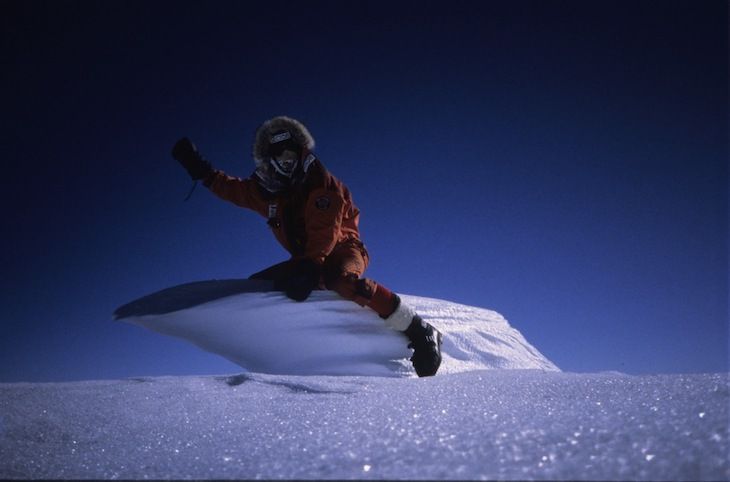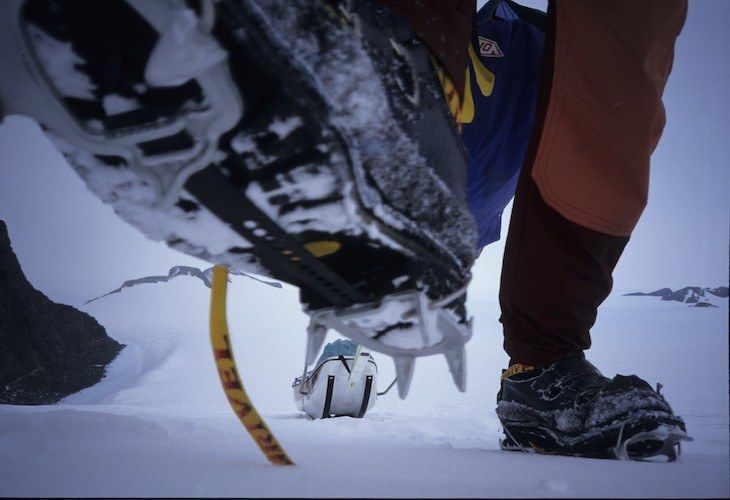The Holy Grail of Antarctic Crossings
Explorer Borge Ousland’s thoughts on Colin O’Brady’s Antarctic crossing

By ROAM
Things have gotten pretty heated in Antarctica as of late. Why? Over past two decades there have been assorted claims to the first unsupported crossing of Antarctica, including Borge Ousland, Sir Ranulph Fiennes, and most recently Colin O’Brady. Colin declared his 900-plus-mile journey the first solo, unsupported, unaided crossing of Antarctica—which was celebrated by the New York Times and National Geographic while the polar community fumed with outrage.
“You might as well be the first to go barefoot, or with one hand in your pocket,” says Borge of the ways people slice and dice their “firsts.” However, the two people to complete the longest, most exploratory journeys require no splicing.
In 1996-97 Norwegian Borge Ousland completed the first ever solo crossing of Antarctica, a 1,864-mile, 64-day coast-to-coast epic that set the standard for Antarctic crossings. Two decades later, in 2017, ROAM founding contributor Mike Horn made an even longer crossing, roughly 3,000 miles, where he arrived and departed by sailboat. Both used kites to harness the wind to cross vast distances, thus making their journeys “aided” according to some.
But what is aid, really? The most recent journeys, Colin and Louis Rudd, followed a marked, manmade “road.” Is that not aid?
Here we asked Borge to share his thoughts on the matter.


Why does it matter to straighten out if Colin O’Brady has earned the first solo, unsupported, unassisted crossing of Antarctica or not?
Borge Ousland: It’s most of all to get the truth out—both for me, and the other few who have trekked and fought with or without the winds across Antarctica. Also for the future explorers who perhaps one day will be able to ski all across Antarctica, coast to coast, without the use of any wind assisted tools. A claim like O`Brady made will steal that opportunity away from those future explorers.
Do people in Norway care much about this controversy?
Borge Ousland: Yes, they do. We are a country of polar explorers, not just pioneers like Roald Amundsen, but also modern athletes like Erling Kagge, Rune Gjeldnes, Cecilie Skog, and Aleksander Gamme, Liv Arnesen, Rolf Bae, and Erik Sonneland have all done impressive feats in Antarctica. So this controversy has created a lot of interest and with social media it is so much more transparent and everyone can compare in a totally different way than before.
You are a polar legend with an incredible number of firsts. How hard was the 1996-97 expedition compared to the others?
Borge Ousland: It was hard, especially mentally since there is so little to focus on in this desolated landscape. It’s just a huge ice desert with so few impulses from the outside, and it takes time to get used to it. The hardest part was the start, leaving that plane and taking the first step on a trip that lasts two to three months. Nobody has done it before, you don’t know what’s going to happen. The landscape is so lonely in Antarctica—until you start to love it, then it’s fine. But nothing can really compare with an unsupported trip to the North Pole. That trip, which I did in 1994, is still undone by others, and it is the trip I am mostly proud of.
Why did you choose your 1996-97 Antarctica route?
Borge Ousland: First of all, I wanted to start and finish from the real coast.
So kites. What’s the big deal about kites?
Borge Ousland: You can do longer distance with kites, which also adds to the difficulty. Some of the really long trips in Antarctica like from Queen Maud Land, can only be done with kites. Using the wind has its own difficulties.


“The landscape is so lonely in Antarctica— until you start to love it, then it’s fine.” — Borge Ousland
Things have changed a lot in 20 years. How did you navigate the route in 1996-1997?
Borge Ousland: During the day I only used a compass and the sun to navigate. To use the sun, I set my watch to local time and followed the shadow from the ski pole to adjust my course. The sun, and therefore also the shadow, moves 15 degrees each hour, it’s easy when you get the hang of it. I also had a large early-type GPS that I used in the tent at night to check my position.
That’s pretty badass. If you had needed a rescue, what would you have done? How long would it take to show up?
Borge Ousland: It depends where you are, due to the terrain and the enormous distance. In some places rescue is just hours away, other places on the route are beyond rescue. For example, in the sastrugi fields (fields with large snowdrifts) that stretch for several hundred kilometers, no plane can land there. Also towards the end of the trip, I was too far away from the base to make it in one flight. I don’t tend to think too much about rescue, it’s better to be careful and do the right thing on the way. This was before satellite phones worked in the polar areas. I had a HF radio which I could rig up by stretching out a 20-meter-long antenna outside my tent and try to connect on pre-agreed times and frequencies. I also had an emergency beacon and a so-called Argos beacon that could transmit an emergency signal with my position.
You mentioned falling into crevasses. What were some of the challenges you encountered?
Borge Ousland: The crevasses, yes, they can be dangerous when you are solo, there is no one to hold the other end of the rope. The wind and the cold and sheer fatigue are also common dangers. The second day of the trip I measured the wind to 33 meters per second. The storm almost destroyed my tent, I had to get out at night to try to reinforce the guylines but the wind was so strong that I had to crawl on the ground. Using my skisail in rough terrain and across those stone hard snowdrifts that are called “sastrugi” was however the most dangerous thing I did. It’s so easy to break some bones or get knocked unconscious when using a skisail or kite in such conditions.
What were some of the joys you encountered?
Borge Ousland: I think one of the greatest joys is when you after a while gradually get the hang of it, when you can lift your head and start to believe that you actually can make it. Being alone for weeks in Antarctica is a form of meditation, you reach levels inside you that you didn’t know existed. I spent two Christmas Eves in Antarctica. Just me in that little tent, the small gifts I had brought with me from home, outside a white desert of snow and that endless universe above. They were the best Christmases I have had.
What were the advantages, disadvantages of going solo?
Borge Ousland: Being solo can be hard, but it’s also the best part of an expedition, emotions are just so much stronger. It goes both ways of course, you can’t hide in Antarctica, bad days can get really bad, good days are so intense that it’s hard to describe. There is no one to lean on, but at the same time you have a deeper dialogue with yourself and also the surrounding nature.
The downside is lack of safety, and it’s heavier since you can’t share all the common equipment like pots, tent, spare equipment etc. But you can choose your own routine, there is no one to argue with and you are in control in a different way. No one to blame if something goes wrong. Success or failure, it’s up to you.





“Being alone for weeks in Antarctica is a form of meditation, you reach levels inside you that you didn’t know existed.” — Borge Ousland
What did you eat on the 1996-97 trip?
Borge Ousland: I had my own home-made porridge for breakfast. For lunch lots of chocolate and a lunch bar with nuts and dried fruit, plus a piece of dried meat. Dinner was freeze-dried meat and mashed potatoes and butter. That was the most important meal of the day, and what I looked forward to. At breakfast you just want to get going. I only drank water.
What impact do you think social media has on explorers like Colin?
Borge Ousland: It has a huge impact. The media world today is so instant. If you do it right and hit the right nerve, the reach can be enormous. If you make it big in social media you can surf on that wave for a long time, you can build a career. But you are not always measured by the content, maybe more by the wrapping. No need to bother with fact-checking, if you choose your words right. Sponsors nowadays don’t ask what you will do, they ask how many followers you have on Instagram. It was different before (now I sound very old…) when you could ski two months to the North Pole for instance, with almost no contact with the outside world other than a few faint words via HF radio, and still hit page after page in various media. And no photos came out, those were only seen a couple of weeks after the trip. So it has been enormous changes. Not sure it’s for the better, but it’s a reality we all have to live with and navigate in.
What is happening with the Ice Legacy Project?
Borge Ousland: The Ice Legacy project, where Vincent Colliard and I plan to cross the 20 greatest icecaps in the world, is coming together nicely. Almost all the glaciers in the world are in fast decline, and someone has to go out there and tell what is happening. The last three years we have crossed the three biggest glaciers in Alaska, and this April we will go to Canada to cross one or maybe two of the glaciers there.
What is the state of exploration today? Who is at the leading edge? Where does exploration need to go next?
Borge Ousland: The leading edge overall today is no doubt Mike Horn. Mike Horn has done so much hard and difficult expeditions the last 30 years, that he in my opinion deserves to be on the crown as the greatest overall explorers of today. When it comes to polar, there are unfortunately not so many young ones coming up from behind and who are really pushing the limits, as far as I can see. The old guys are still the ones with the most impressive expeditions it seems. (Please enlighten me if I missed some big feats lately).
Where does it go from here? David Hempleman-Adams once said that the same that happened in Himalayas, will happen in the polar regions, the first Frenchman or Danish, the fastest etc, and that has happened. You still see true exploration from time to time, but since a lot of the big trips have been done what’s left is increasingly difficult. One example is Mike Horn’s latest feat in 2017, where he sailed to the coast of Antarctica, crossed the whole of Antarctica, and sailed out from the other side, all in one go. That was unthinkable just a few years back. But he did it and I think it’s still possible to do great things in the polar regions. Another great explorer, one of the greatest, Reinhold Messner, once said to me, “It’s not the road, the length, or how fast you do it that matters, it’s how you do it that matters.” I agree with that.

Check out our next Expedition: David Lama Makes First Ascent of Nepal Peak
